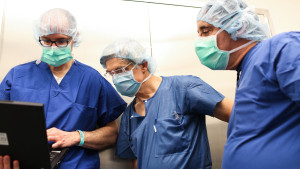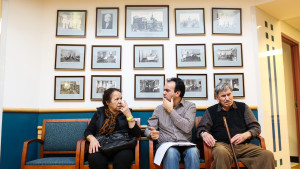WASHINGTON — Adolph Levi lost his hearing as a baby and his sight as a grandfather. Now, thanks to modern technology and a new type of eye surgery, he is learning to see again.
“It is referred to as a bionic eye,” says his son Abie Levi, who served as his father’s voice during the procedure at the Johns Hopkins Wilmer Eye Institute.
It’s not a substitute eye, but it literally brings light to the blind — or at least those who have a condition called retinitis pigmentosa, where vision gradually recedes but the retina is left intact.
The bionic eye is comprised of two different parts. Glasses with a mounted video camera capture images and transmit them to a surgical implant in the eye. The implant then transforms the images into electrical signals and sends those impulses to the retina, which relays them to the brain.

It is brand new technology, and while the Wilmer Institute was involved in clinical trials, Adolph Levi was the first person chosen to get the device at Hopkins once it was cleared for commercial use.
“My dad was extremely excited,” says Abie, who remembers his 83-year-old father telling him before the surgery: “’In my lifetime, I am possibly going to be able to see you again.’”
The Levi family traveled from Brooklyn, New York to Baltimore, Maryland for the operation, with Abie — an occupational therapist by training — taking on the role of translator. He used a mix of gestures and sign language to relay information between the medical staff and his father.
“He has the double whammy of being deaf and blind,” says Dr. James Handa, the Hopkins ophthalmologist who performed the surgery and placed an implant just 6 millimeters in diameter into Levi’s eye.
“If you know the Cheerios cereal, the inside hole is about 6 millimeters,” Handa says. “So, it will basically fit into a little Cheerio.”
The bionic eye device is officially called the Argus II Retinal Prosthesis. Part of it is placed on the eye to catch the signal from the glasses, and the rest of the device — the implant with all those tiny electrodes — is attached to the back eye wall.

“In essence, it is like using a thumb tack — like attaching a piece of paper onto a blackboard,” Handa says.
The magic happens after the surgery, when the patient puts on those special glasses and the camera goes to work. That’s when after all that darkness, there are blips of light.
Abie remembers his dad’s reaction and the joy on his father’s face when he could distinguish some very rough shapes.
“He could make out that there was something in front of him, to the side of him, or below him with this bionic eye. It really opened up his world,” he says.
Adolph may never be able to make out faces, but he will, in time, see silhouettes and, perhaps more importantly, the shapes of sign language.
But it will not happen overnight.
“There is very clearly a learning process that a patient must undergo because most of the patients haven’t seen for 20 years,” Handa says.
“They are having to compare a memory of what vision is like to the actual dots of light — and for many people it is just spots of light until they can learn the nuances of the brightness of the light dots, the grayness of it, the patterns and the movement to it.”
Handa stresses the new technology is just the beginning; it “opens up a whole range of possibilities,” he says.
The Johns Hopkins Applied Physics Lab received a $4 million grant to work with Second Sight, the company that developed the Argus II, on a second-generation retinal prosthesis device.
Handa says one goal will be to improve the resolution from the 60 dots of light transmitted by the Argus II to thousands of dots. This will help patients get a much clearer image — similar to the transition from a regular TV to a high definition plasma screen.
And like an old-fashioned first-generation television, the first-generation bionic eye only transmits images in black and white. Bringing in color will also be a component of future research, as will finding ways to make the technology work for other forms of vision loss beyond retinitis pigmentosa.
So far, about a dozen hospitals around the country are performing the surgery, and more than 60 patients have received the implants.
“It has been a ‘wow’ from the beginning,” says Handa, noting an ophthalmologist named Mark Humayun — a former colleague — came up with the concept while getting a Ph.D. in biomedical engineering two decades ago.
“Everybody laughed about it; they just thought it was really too ambitious as a project to really accomplish in our lifetime,” says Handa, who adds that advances in the study of vision pathways and bioengineering made the bionic eye a reality much sooner than anyone expected.
“It has really been an inspiration and humbling, and nothing short of amazing,” he says.
The bionic eye: Adolf’s story







